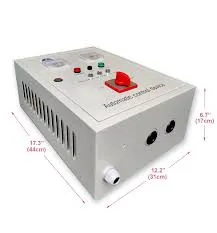Types of Electrical Insulation Tape A Comprehensive Guide
Electrical insulation tape is an essential tool used in various electrical applications to provide insulation, protection, and safety. Available in different types and materials, each variant serves specific purposes depending on the requirements of the task at hand. Understanding the different types of electrical insulation tape is crucial for professionals and DIY enthusiasts alike. This article will explore the main types of electrical insulation tape, their characteristics, and their appropriate applications.
1. PVC Electrical Insulation Tape
Polyvinyl Chloride (PVC) tape is one of the most commonly used types of electrical insulation tape. It is known for its excellent insulation properties, flexibility, and resistance to moisture, acids, and alkalis. PVC tape can be used for a wide range of applications, including insulation of electrical wires, color coding, and securing wires and cables together. Additionally, it is available in multiple colors, making it suitable for organizing and identifying different circuits.
2. Vinyl Electrical Insulation Tape
Vinyl tape is similar to PVC tape but is specifically designed for electrical applications. It provides excellent insulation, is highly resistant to environmental factors such as UV light and extreme temperatures, and is also flame-retardant. Vinyl electrical tape is ideal for indoor and outdoor use and works well in conditions where extreme weather could affect the integrity of the insulation.
3. Rubber Electrical Insulation Tape
Rubber insulation tape offers superior electrical insulation performance. It is often used in high-voltage applications, where its ability to withstand extreme temperatures and its superior adhesive properties are essential. Rubber tape can stretch and conform to irregular shapes, making it an excellent choice for splicing and repairs. However, it is typically more expensive than PVC or vinyl tapes, so its use is limited to situations where its specific properties are needed.
electrical insulation tape types

4. Self-Fusing Silicone Tape
Self-fusing silicone tape is a unique type of electrical insulation tape that does not have adhesive. Instead, it fuses to itself when wrapped around an object, creating a watertight and airtight seal. This tape is ideal for emergency repairs, as it can seal leaks in hoses, pipes, and even electrical wires. Self-fusing silicone tape also withstands extreme conditions, making it suitable for outdoor and automotive applications.
5. PTFE Electrical Insulation Tape
Polytetrafluoroethylene (PTFE) tape, commonly known as Teflon tape, is used primarily for insulating and sealing in electrical connections. Its non-stick surface reduces friction, making it ideal for applications involving pipe threads. While not as common as other types of insulation tape, PTFE tape is valuable in specific electrical setups, especially in high-frequency applications.
6. Mica Tape
Mica tape is a specialized type of electrical insulation tape made from layers of mica, a natural mineral known for its exceptional thermal resistance and electrical insulating properties. Mica tape is extensively used in applications requiring high-temperature resistance, such as in the insulation of motor windings and transformers. Its ability to withstand extreme conditions makes it invaluable in industries such as aerospace and power generation.
Conclusion
Choosing the right type of electrical insulation tape is essential for ensuring the safety and efficacy of electrical systems. Each type of tape serves specific purposes and is designed to withstand different environmental conditions. By understanding the strengths and appropriate applications of PVC, vinyl, rubber, self-fusing silicone, PTFE, and mica tapes, users can make informed decisions to enhance the longevity and reliability of their electrical projects. Whether for professional use or DIY tasks, the right insulation tape is critical for electrical safety and performance.
-
XIANGFAN Rubber Tape-Ultimate Solutions for All Your Insulation NeedsNewsJun.24,2025
-
XIANGFAN Rubber Tape-Protection for Industrial and Residential ApplicationsNewsJun.24,2025
-
XIANGFAN Rubber Tape: Superior Safety and Sealing for Demanding EnvironmentsNewsJun.24,2025
-
XIANGFAN Rubber Tape: Reliable Solutions for Every Electrical ChallengeNewsJun.24,2025
-
XIANGFAN Electrical & Industrial Tape: Powering Reliability Across IndustriesNewsJun.24,2025
-
XIANGFAN Electrical & Industrial Tape: Excellence in Every ApplicationNewsJun.24,2025
